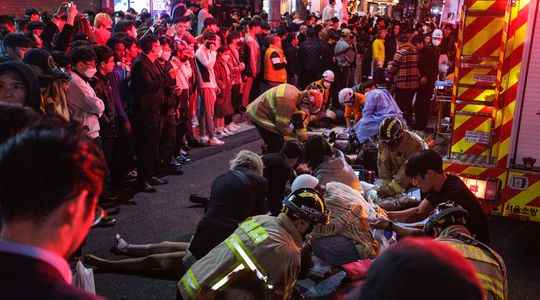A tangle of bodies stacked on top of each other, some in agony, others struggling to stay conscious. It’s around 10:27 p.m. in Seoul, and what was supposed to be an impromptu night of celebration after two years of health crisis has just turned into a nightmare. In the narrow streets of Itaewon, a fashionable district of the South Korean capital since the broadcast of a successful series, the young people who have come to celebrate Halloween are upside down, suffocating. A crowd movement has just started.
In the early morning, the number of dead was still not stopped. How could such a tragedy happen? If the “rigorous” investigation, promised by South Korean President Yoon Seok-youl, is not complete, the literature on the dynamics of human gatherings, a burgeoning academic field, highlights similarities between what led to the death of 156 people that evening, and the other deadly movements – the most spectacular of which had 2,300 victims in Mecca in 2015.
When too dense, the crowd turns into a potentially deadly trap. A mine, that nothing can trigger. A rumor about the presence of a star, the impatience to participate in the vampire ball after two years of cancellation Covid-19, or just too much enthusiasm. “In reality, it doesn’t matter”, cuts Mehdi Moussaïd, researcher in crowd behavior at the Max-Planck Institute, in Germany. “Beyond a threshold of squared people, the dynamic shifts from psychosocial to purely physical. Calling for calm no longer works.”
A systematic gear
Works of CNRS, from ENS Lyon and Université Lyon 1 published in Science in 2019 demonstrated that at high density, the crowd behaves like a liquid, propagating increasingly strong forces and pressures, despite the crowd’s attempts to resist. This limit passed, a gear, is put in place with low noise, until causing a sudden compression of the crowd, being able to involve the asphyxiation of hundreds of people.
A mechanism so implacable, that it is predictable. Algorithms are now able to reproduce the movements of crowds, despite the unpredictability of individual decisions. This Tuesday, President Yoon also called on the country to acquire “advanced digital skills” to improve its crowd management, while Seoul City Hall already has a real-time density control system.
That evening, it was not activated, according to local media, but images and statements about the incident show that this threshold was crossed. In the alley that winds between Itaewon Station and Thirst Street where the crowds went, a sloping alley, 45 meters long and 3 meters wide, up to 9 people were gathered per square meter , shortly before the tragedy, according to the count of L’Express. Beyond 7, scientists agree that the situation is too risky.
Movements spread like waves
In Itaewon, revelers first massed in an attempt to get to their favorite bar, walking back and forth down the alley. “These two-way flows enhance congestion, they are to be avoided, but here, the gathering was self-organized and therefore difficult to regulate”, describes Mehdi Moussaïd, also a popularizer on the YouTube channel. Fouloscopy. District authorities admitted on Tuesday that they considered the evening to be “a phenomenon” rather than a “festival”, which would have required a traffic plan.
From 8:30 p.m., a traffic jam forms. According to the police and messages on social networks, some participants are trying to warn of the dangerousness of the gathering. Little by little, the crowd begins to undulate in one direction then in the other. The faces bear witness to an inability to resist this phenomenon. “Rush waves”, well known to scientists. “The slightest movement is transmitted from person to person, like a wave. If they cross or reverberate on the walls, the pressure increases further”, continues Mehdi Moussaïd.
By the time you realize the danger, it’s already too late
Why didn’t the crowd try to regulate itself? “By the time people begin to sense the danger, it’s often too late, too congested. At the epicenter, no one can leave.” The trap is closed. “We can’t just block the lanes to stop the flow. The pressure could rise at the level of these dams. They could in turn create the conditions for an incident to occur”.
At 10:00 p.m., people fell at the top of the alley, according to eyewitnesses. At the same time, down the street, a dense crowd was coming from the opposite direction, amplifying the pressure. “At such a level of compression, getting up is very difficult. People on the ground then get in the way. Each knocks the other down and the bodies pile up very quickly”, explains the researcher. It will take more than two hours for help to clear this fatal human pyramid.
The crowd movement in Seoul is one of the deadliest in the past ten years. But as city centers get denser, and events get bigger, accidents go down. “Science is advancing, the organizers are better informed and the public is increasingly aware, but we still have to progress in this direction”, explains the specialist, who helps to inform about the right reflexes. And to conclude: “Everything is played before the event”.
